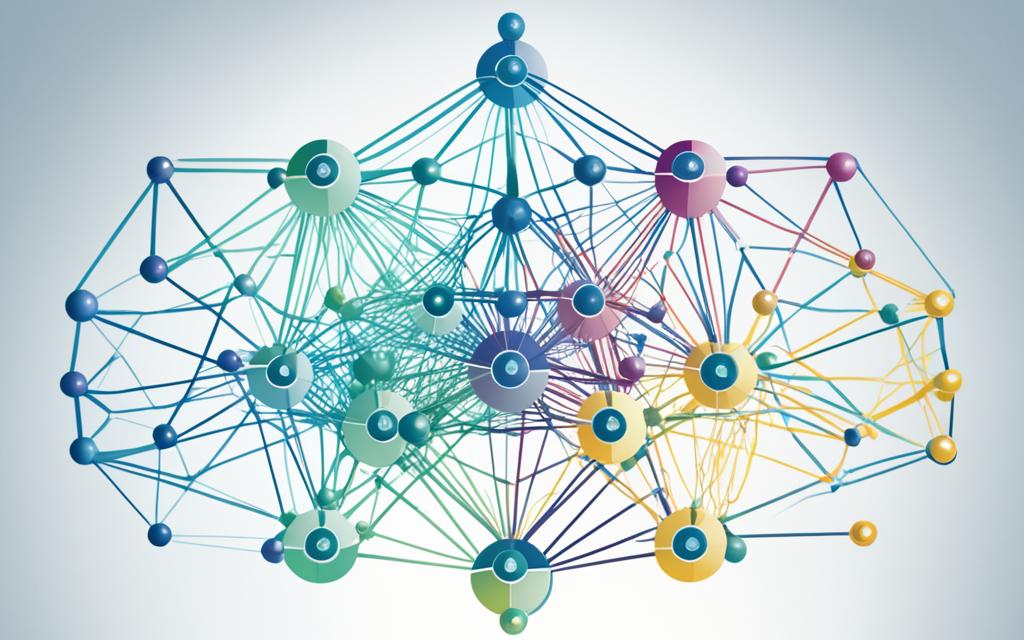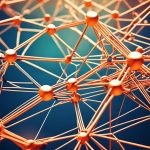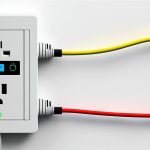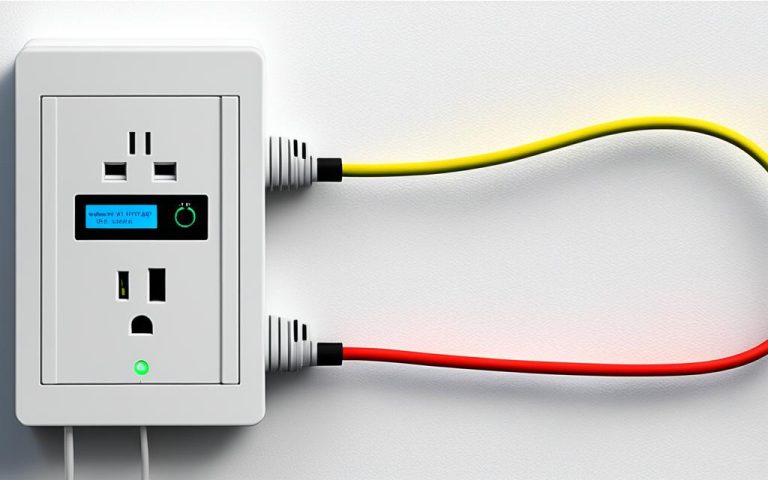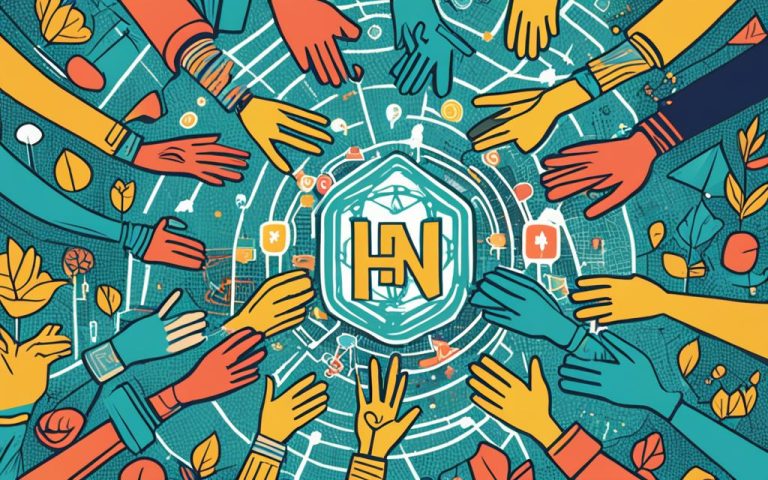Network analysis sheds light on how relationships work in different networks, like social media. It looks at how nodes and edges connect to understand the network’s inner workings. This helps spot key people, group traits, and future trends. It’s also used in social media to suggest friends or followers1.
Knowing how networks are structured is key to figuring out who’s part of what group. It helps companies spot important figures, see which channels work best, and make smart choices about working together. By tracking clicks on affiliate links, it’s easier to see which partners are most or least effective1.
Key Takeaways:
- Network analysis gives insights into social media relationships1.
- Understanding network structure helps spot key players and groups1.
- Looking at affiliate links helps in making better partnership choices1.
Measuring Network Centrality: Identifying the Important Node
Measuring network centrality is key in network analysis. It helps find the most important node in a network. Different methods give us insights into the network’s structure and how it works. This lets us spot influential nodes and see their effect on the network.
Degree centrality counts how many direct connections a node has. Nodes with many connections are like hubs. They play big roles in sharing information, allocating resources, and network performance2.
Betweenness centrality looks at how often a node connects other nodes. Nodes with high betweenness centrality are key in linking different parts of the network. They help keep the network connected and ensure info flows well23.
Closeness centrality finds the shortest paths from a node to all others. Nodes with high closeness centrality can quickly reach other nodes. They have a big influence because they’re easy to get to. They can spread info or resources fast, making them important in the network24.
Eigenvector centrality looks at a node’s connections and those of its neighbors. It sees how close a node is to influential nodes. Nodes with high eigenvector centrality are connected to other important nodes, making them influential too4.
Each centrality measure shows different things about networks, like power, info flow, and influence. Using several measures together gives a full picture of the network and its key players. Centrality analysis is useful in many areas, like social networks, transport, and sharing info24.
Let’s dive into the different centrality measures and what they mean:
| Centrality Measure | Definition | Applications |
|---|---|---|
| Degree Centrality | Counts the number of connections a node has within the network | Identifying key brokers in social networks23 |
| Betweenness Centrality | Measures how often a node acts as a bridge along the shortest path between other nodes | Identifying critical nodes for maintaining network connections23 |
| Closeness Centrality | Calculates the average length of the shortest paths from a node to all other nodes | Assessing the efficiency of information dissemination within a network24 |
| Eigenvector Centrality | Considers a node’s connections and the connections of its neighboring nodes | Identifying influential nodes based on their connections to other influential nodes4 |
Understanding network centrality is key to grasping network structure and dynamics. By using different measures, analysts can spot the most influential nodes and their effects. Centrality measures help in many ways, like finding key brokers, improving info flow, or checking network strength243.
Community Detection: Finding Similar Groups in a Network
Community detection is key in network analysis. It helps divide a network into groups with similar traits or interests. This is very useful in social media, where it finds groups of users with the same interests or views.
Many algorithms and methods help with this task. For example, Agglomerative and Divisive Methods are used to find communities in networks5. These methods merge or split nodes based on how connected they are and their traits.
Key Community Detection Algorithms
Several algorithms help find these groups of nodes. The Louvain Community Detection algorithm was introduced in 20085. It aims to maximize the difference between actual and expected edges in a community. This makes it quick and effective, especially for big networks.
The Surprise Community Detection algorithm uses Surprise probabilities to check how good a network partition is5. It tries to improve surprises when nodes move between communities, leading to better community detection.
The Leiden Community Detection algorithm, from 2019, focuses on solving disconnected communities found by the Louvain algorithm5. It does this with extra refinement steps, making sure communities are well-connected and match the network’s structure.
The Walktrap Community Detection algorithm is different, using random walks to find densely connected parts that are communities5. It merges nodes based on how they behave in random walks, in a bottom-up way.
Applications in Recommendation Systems
Community detection isn’t just for social media. It’s also used in making recommendation systems. These systems use it to find groups of users with similar tastes, making recommendations more accurate.
By understanding network structures through community detection, recommendation systems can better analyze user behavior and preferences5. This is better than traditional methods, especially for handling single nodes and finding detailed communities.
With community detection, recommendation systems can offer personalized suggestions to social media users, fitting their unique interests and tastes.
Overall, community detection is vital in network analysis. It helps us find hidden groups and structures in networks. Its uses go beyond social media, like in recommendation systems. By using these algorithms, we can understand network dynamics and the behavior of connected entities better.
Network Analysis in Various Fields
Network analysis is not just for social networks. It’s used in many areas like time series analysis, natural language processing, telecommunication network analysis, and machine learning.
In time series analysis, it helps find patterns and changes over time. It looks at how data points relate to each other. This can lead to better forecasting and trend spotting6.
Natural language processing uses network analysis to study language structure. It turns words into nodes and their co-occurrences into edges. This helps understand how words relate to each other and group documents together6.
For telecommunication network analysis, network tools are key. They help find important nodes and how data flows. This info is used to better manage networks and improve performance6.
Machine learning has also seen big benefits from network analysis. Techniques like graph embedding and graph neural networks use network concepts. They help machines learn about nodes and edges, making tasks like recommendations and predicting links easier6.
Applications of Network Analysis
Network analysis is crucial in many areas. It helps in time series analysis, natural language processing, telecommunication network analysis, and machine learning. By finding relationships and patterns, it gives insights for better decisions and solving problems.
| Field | Application |
|---|---|
| Time Series Analysis | Uncovering patterns and changes over time |
| Natural Language Processing | Analyzing language structure and semantic relationships |
| Telecommunication Network Analysis | Optimizing communication networks and resource allocation |
| Machine Learning | Graph embedding and graph neural networks for advanced analysis |
When combined with deep learning, network analysis opens new doors in research and innovation. It’s pushing forward in areas like graph-based machine learning and complex data analysis6.
By using network analysis, experts and practitioners get valuable insights. They can improve processes and drive progress in their fields. The future looks bright as network analysis grows with data and technology.
Importance of Social Media Analytics
Social media analytics is key for today’s marketing plans. It gives deep insights and data to boost success. By using social media analytics, companies can see how well their campaigns work, know their audience, and make smart choices to increase ROI.
It helps analyze performance metrics like impressions, reach, likes, and comments. These metrics let marketers see the effect of their social media efforts. This helps them improve their content and strategies for better engagement and conversions7.
Knowing who the audience is is also vital. By looking at age, gender, location, and interests, companies learn what their audience likes and needs. This info helps them make marketing that really speaks to their audience and gets better results7.
Social media analytics gives you the power to track and measure every facet of your social media efforts. It helps you understand your audience better, create more engaging content, measure your success, and make data-driven decisions. – Quid Social8
Looking at competitors is another big part of social media analytics. By seeing what competitors do and how well it works, companies can get ahead. This gives insights into trends, successful tactics, and new chances for growth. With this info, companies can improve their own plans and stand out from the competition9.
Influencers have a big impact on social media. Social media analytics helps see how influencers affect brand awareness, reach, and engagement. By knowing who these influencers are, companies can work with the right ones. This helps spread their brand message wider9.
Also, social media analytics looks at how people feel about brands. It checks the tone and intent of comments to see if they’re positive, negative, neutral, or in between. Brands use this to see how people feel about them. This helps them make changes to improve how people see them9.
Moreover, it shows how well paid ads work. By looking at things like click-through rates, conversion rates, and ad impressions, companies can make their ads better. This way, they use their marketing budget wisely and get more from it9.
Finally, social media analytics gives a full view of how people feel about a brand. By looking at customer feedback, comments, and mentions, companies can see what people think. This helps them know what to improve, fix customer issues, and build a strong brand image8.
Case Study: Brand A’s Success with Social Media Analytics
Brand A, a top skincare company, used social media analytics to boost their marketing. They found their audience was mostly millennial women aged 18-34 who liked natural and organic skincare. With this info, they made content just for them and worked with influencers who shared their values. This led to more online sales and made them a trusted brand in skincare7.
| Statistics | Percentage | Source |
|---|---|---|
| 92% of marketers in companies with more than 100 employees were expected to start using social media analytics tools by 2022 | 92% | Source 1 |
| 95% of all purchase decisions are made with emotion | 95% | Source 1 |
| Companies that are customer-centric are reported to be 60% more profitable than those that are not | 60% | Source 1 |
| 56% of marketers use social data for understanding their audience | 56% | Source 3 |
| 49% of marketers use social data to develop creative content | 49% | Source 3 |
In conclusion, social media analytics gives businesses key insights into their audience, campaign success, and brand sentiment. By using these insights, companies can make smart choices, improve their marketing, and get better results. With social media’s growing role in the digital world, using social media analytics is crucial for businesses to stay ahead and succeed897.
Types of Social Media Analytics
Social media analytics are key to checking how well marketing works on different platforms10. Each platform has its own analytics tools10. But, there are also many social media analytics tools that give a deeper look at performance10. It’s important to know the different types of analytics and what they mean for making good social media plans.
Trendspotting: Pinpointing Upcoming Trends
Trendspotting means finding out what’s new and what’s going to be big in social media10. It looks at which platforms are getting more popular, and what topics or influencers are in the spotlight10. By knowing these trends, businesses can use them to their advantage and connect better with their audience.
Brand Sentiment Analysis: Measuring Customer Perception
Brand sentiment analysis helps businesses see how people feel about them or their products10. It shows how customers think, feel, and react to the brand10. This info helps businesses know what to improve and make sure their messages hit the mark.
Value Perception: Determining Demand and Pricing
Understanding how people see the value of a product or service is key for businesses10. It helps figure out how much people want something and what to charge for it10. By looking at value perception, businesses can make sure their offerings meet customer needs and expectations.
Social Media Goals: Setting Actionable Objectives
Social media analytics help set clear goals and track progress10. By looking at things like views, likes, and sales10, businesses can shape their social media plans to get the results they want. Keeping an eye on these goals helps businesses see how they’re doing and make changes to get better results.
Proving ROI: Monitoring Campaign Performance
Social media analytics are key to showing the value of social media marketing10. By tracking how campaigns perform and the sales they generate10, businesses can see if their social media efforts are working. Looking at metrics like conversions and sales helps businesses understand the real impact of their social media marketing.
Audience Analytics: Understanding Demographics and Preferences
Audience analytics give businesses insights into who their audience is10. It shows things like age, gender, and what devices they use10. Knowing this helps businesses tailor their messages and content to better connect with their audience. By understanding what people like, businesses can create experiences that keep people coming back.
Competitor Analysis: Gaining a Competitive Edge
Competitor analysis lets businesses see how they stack up against others10. By comparing things like follower numbers and engagement10, businesses can spot areas to improve and learn from others in their field. This helps businesses stand out and stay ahead in the game.
Paid Social Analytics: Maximizing Advertising Impact
Paid social analytics focus on how paid ads perform on social media10. It looks at things like ad views, clicks, and how much it costs to get those results10. By analyzing these metrics, businesses can make their ads more effective, use their budget wisely, and get better results from their paid social media campaigns.
Influencer Analysis: Tracking Influencer Marketing Success
Influencer analysis helps businesses see how well their influencer marketing is doing10. By tracking things like engagement and audience size related to influencers10, businesses can find the best influencers for their brand. This helps businesses make smart choices for future collaborations and use influencers to reach and engage their audience.
Sentiment Analysis: Monitoring Brand Perception
Sentiment analysis is important for keeping an eye on how people feel about a brand10. It looks at how positive or negative people are about a brand or certain topics10. By tracking sentiment, businesses can quickly address any negative feelings and build on positive ones to boost customer loyalty and advocacy.
| Types of Social Media Analytics | Definition |
|---|---|
| Trendspotting | Identifying upcoming trends and shifts in the social media landscape10 |
| Brand Sentiment Analysis | Measuring how people feel about a brand, including positive, neutral, and negative sentiments10 |
| Value Perception | Determining demand and pricing based on customer perception10 |
| Social Media Goals | Setting actionable objectives and monitoring performance against them10 |
| Proving ROI | Demonstrating the return on investment of social media marketing efforts10 |
| Audience Analytics | Understanding audience demographics and preferences10 |
| Competitor Analysis | Benchmarking performance against competitors and gaining insights into industry trends10 |
| Paid Social Analytics | Analyzing metrics related to paid advertising campaigns on social media platforms10 |
| Influencer Analysis | Tracking the success of influencer marketing campaigns10 |
| Sentiment Analysis | Monitoring brand sentiment and user perception10 |
Social Media Analytics Tools
Using social media analytics tools is key for businesses to measure and boost their social media performance. These tools give insights and data that help businesses improve their social media plans. They also help businesses connect with their audience better and get meaningful results.
Sprout Social offers a wide range of analytics tools. It helps businesses track their performance on many social media platforms. This makes it great for performance analysis and audience analytics11. With its customizable reports, businesses can easily see their post reach, how often people interact with their posts, how many new followers they get, and even how many sales or conversions they make11. It also has competitor analysis, helping businesses see what their competitors do and how they can do better11. Plus, Sprout Social’s paid social analytics lets businesses track how well their ads do, how many people click on them, and how many new followers they gain11. It also has sentiment analysis, helping businesses keep an eye on how people feel about their brand and make better decisions11.
Sendible is another powerful tool for social media analytics. It gives businesses detailed analysis and reporting tools, automated reports, and ways to engage with their audience11. With Sendible, businesses can learn a lot about how their social media posts do, who mentions them, and who they’re talking to11. This helps them improve their social media plans, make better content, and connect with their audience more deeply11.
Keyhole is great for real-time monitoring and analysis. It lets brands watch their brand sentiment, see what their competitors do, track trends, and see how influencers perform on different platforms11. Keyhole’s features help businesses make smart decisions from the huge amount of social media data. This helps them succeed in their social media efforts11.
If your business works with influencers, IZEA is the best tool for you. It focuses on influencer marketing analytics. It gives insights into how influencers reach people, how engaged they are, who they talk to, and how well their campaigns do11. With IZEA, businesses can find the best influencers to work with and see how well their campaigns are doing11.
BuzzSumo is great for analyzing social engagement on content. It helps businesses see how well their content does and how it compares to their competitors. By looking at engagement data, businesses can plan their content better. This helps them make content that really speaks to their audience11.
Google Analytics gives a full view of social media performance and website traffic. It shows how social media campaigns affect website visits and measures their social ROI through specific reports11.
Followerwonk is a tool just for Twitter analytics. It helps brands connect with users, compare accounts, track followers, and improve their Twitter strategy with valuable insights11. With Followerwonk, businesses can understand their Twitter audience better, find influencers in their field, and make their Twitter presence stronger11.
Rival IQ is great for competitor analysis. It offers insights on competitors, basic social analytics, social listening, reporting, and tracking influencers across different channels11. By using Rival IQ, businesses can see how they stack up against competitors, find areas to improve, and stay on top of industry trends11.
Iconosquare started as an Instagram analytics tool but now covers many platforms. It lets businesses keep an eye on stats on platforms like Facebook, Instagram, LinkedIn, and TikTok11. Iconosquare’s tracking and reporting help businesses make smart decisions to improve their social media strategies and succeed11.
In conclusion, using social media analytics tools is crucial for businesses wanting to boost their social media performance. Tools like Sprout Social, Sendible, Keyhole, IZEA, BuzzSumo, Google Analytics, Followerwonk, Rival IQ, and Iconosquare offer insights that help businesses refine their strategies, connect with their audience, and reach their social media goals11.
Networking: Connecting Professionals for Growth and Opportunities
Networking is about sharing info and ideas with others in your field. It’s key for connecting pros and helping them grow12. It helps people keep up with trends, find jobs, and make important business contacts12. Now, networking has grown to include both old-school and online ways13. You can network at events, through groups, or even just by talking to people in real life13. Did you know 31% of job seekers find jobs through their contacts? That shows how powerful networking is12. Plus, 23% send their resumes through friends, proving the value of personal connections12.
Expanding Horizons through Networking
Networking isn’t just for jobs; it’s also about growing and learning13. It lets you meet peers, leaders, and mentors who can share their wisdom12. Getting advice from more experienced pros can help you learn new skills and find new chances12. And, top leaders often use networking to get noticed and become industry experts12.
The Role of Social Media in Networking
Social media has changed the game for networking12. Sites like Twitter and Instagram let you connect with others and share ideas, which helps everyone learn and work together12. LinkedIn, for example, had 6.3 million people at its events in 2020, showing how online networking works12. Social media lets pros reach more people, make new friends, and keep up with the latest news.
Effective Networking Strategies
To get the most from networking, try different methods13. Going to events, joining groups, and getting advice from experts can really help13. Using LinkedIn to connect with others can also grow your network and share info13.
The Power of Networking for Career Advancement
Networking is key for moving up in your career12. 76% of people think knowing the right people is crucial for growing your career12. It opens doors to new views, advice, and lasting relationships, all of which help you grow personally and professionally13. Having the right contacts can lead to better job chances and help you find your dream job13. Networking can open new doors and boost your reputation in your field13.
| Statistic | Source |
|---|---|
| 31% of job seekers find listings through professional connections, especially referrals | 12 |
| 23% of people submit resumes through friends or former colleagues | 12 |
| 6.3 million people attended virtual events on LinkedIn in 2020 | 12 |
| 76% of individuals believe that knowing the right people is essential to career advancement | 12 |
Conclusion
Networking is key for professionals and business owners wanting to grow their careers and businesses. It helps you meet new people and make valuable connections. This can lead to new opportunities and success.
Networking lets you meet people from different fields and backgrounds. These connections can offer advice, support, and chances to work together. It’s a great way to grow personally and professionally.
Online platforms like LinkedIn have changed how we network. They let you join groups, talk about topics, and share your skills with more people. You also get updates on industry trends, helping you stay ahead in your field.
By choosing the right networking events and adding value, you can make strong connections. These connections can lead to new jobs, partnerships, and success. Networking is crucial for moving forward in your career and business. It helps you stay connected and grab opportunities in our global world141516.
FAQ
What is network analysis?
Network analysis is a tool to understand how things connect in networks, like social media. It uses nodes and edges to show these connections. Nodes are things or people, and edges show how they relate.
How is network centrality measured?
We measure network centrality with indicators like degree centrality and eigenvector centrality. These show which nodes are key in a network.
What is community detection in network analysis?
Community detection finds groups in a network that share similar traits or interests. It’s useful for spotting user groups in social media.
In what fields is network analysis used?
Network analysis is key in fields like time series analysis and natural language processing. It’s also used in telecommunication and machine learning.
Why is social media analytics important?
Social media analytics track marketing success and prove ROI. They help evaluate campaigns and guide social media strategies. They offer insights into audience behavior and campaign effectiveness.
What are some types of social media analytics?
Types include trendspotting and brand sentiment analysis. Each type offers unique insights for social media strategies.
What tools are available for social media analytics?
Tools like Sprout Social offer analytics for social media. They cover performance, audience, and competitor analysis, among others.
What is networking and why is it important?
Networking is sharing info and ideas with others in a similar field. It helps expand your network, find jobs, and stay updated. It’s key for career and business growth.
How can professionals network effectively?
To network well, target the right groups and build meaningful connections. Online platforms like LinkedIn offer chances to connect and share info.
Source Links
- https://modo25.com/news-insights/affiliates/affiliate-marketing-kpis-what-and-how-to-measure-affiliate-marketing/ – Affiliate marketing KPIs: What and how to measure affiliate marketing | Modo25
- https://visiblenetworklabs.com/2021/04/16/understanding-network-centrality/ – Network Centrality: Understanding Degree, Closeness & Betweenness Centrality – Visible Network Labs
- https://www.networkpages.nl/centrality-measures-who-is-the-most-important-in-a-network/ – who is the most important in a network? – The Network Pages
- https://cambridge-intelligence.com/keylines-faqs-social-network-analysis/ – Social network analysis 101: centrality measures explained
- https://towardsdatascience.com/community-detection-algorithms-9bd8951e7dae – Community Detection Algorithms
- https://towardsdatascience.com/network-analysis-d734cd7270f8 – Network Analysis
- https://keyhole.co/blog/social-media-analytics/ – What Is Social Media Analytics & Why Is It Important?
- https://www.quid.com/knowledge-hub/resource-library/blog/what-is-social-listening-why-is-it-important/ – What Is Social Media Analytics & Why Is It Important?
- https://www.ibm.com/topics/social-media-analytics – What Is Social Media Analytics? | IBM
- https://sproutsocial.com/insights/social-media-analytics/ – Social media analytics: The complete guide
- https://sproutsocial.com/insights/social-media-analytics-tools/ – 20 of the best social media analytics tools for your brand in 2024
- https://www.betterup.com/blog/networking – What Is Networking and Why Is It So Important? (Plus Tips)
- https://www.michaelpage.com.au/advice/career-advice/career-progression/top-12-benefits-networking-why-networking-important – Top 12 benefits of networking: Why networking is important | Michael Page
- https://azhin.org/cummings/basiclitreview/conclusions – AZHIN: Writing: Literature Review Basics: Conclusions
- https://nap.nationalacademies.org/read/11516/chapter/10 – 8 Conclusions and Recommendations | Network Science
- https://www.ncbi.nlm.nih.gov/books/NBK44720/ – Conclusions and Recommendations – Networking Health

